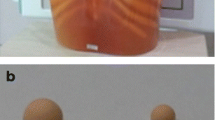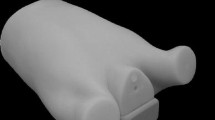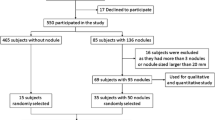Abstract
Purpose
The aim of this study was to investigate how much the radiation dose can be reduced for the identification and characterization of focal ground-glass opacities (GGOs) by high resolution computed tomography (HRCT).
Materials and methods
A chest CT phantom including GGO nodules was scanned with a 40-detector CT scanner. The scanning parameters were as follows: tube voltage 120 kVp; beam collimation 32 × 1.25 mm; thickness and intervals 1.25 mm; tube current and rotation time 180, 150, 120, 90, 60, and 30 mA. 180 mA was the standard. Using a three-point scale at different currents, we visually evaluated image quality. Furthermore, we carried out observer performance tests using receiver operating characteristic (ROC) analysis to evaluate the ability to identify GGO nodules at each current.
Results
By visual analysis, the scores for all particulars were significantly lower on images obtained at less than 120 mA than at 180 mA (Steel’s test, P < 0.05). There was no statistically significant difference in any particulars other than artifact on images obtained at 180, 150, and 120 mA. By ROC analysis there was no statistical difference in the Az value to identify GGO nodules on images obtained at 180, 150, 120, 90, or 60 mA. However, the Az value at 30 mA was significantly lower than at 180 mA (Dunnett’s test, P < 0.01).
Conclusion
The minimum current necessary for the characterization of GGO nodules on HRCT was 120 mA, although their identification was possible at currents of >30 mA.
Similar content being viewed by others
References
Austin JH, Muller NL, Friedman PJ, Hansell DM, Naidich DP, Remy-Jardin, et al. Glossary of terms for CT of the lungs: recommendations of the Nomenclature Committee of the Fleischner Society. Radiology 1996;200:327–331.
Kodama K, Higashiyama M, Yokouchi H, Takami K, Kuriyama K, Mano M, et al. Prognostic value of ground-glass opacity found in small lung adenocarcinoma on high-resolution CT scanning. Lung Cancer 2001;33:17–25.
Kuriyama K, Seto M, Kasugai T, Higashiyama M, Kido S, Sawai Y, et al. Ground-glass opacity on thin-section CT: value in differentiating subtypes of adenocarcinoma of the lung. AJR Am J Roentgenol 1999;173:465–469.
Nakajima R, Yokose T, Kakinuma R, Nagai K, Nishiwaki Y, Ochiai A. Localized pure ground-glass opacity on high-resolution CT: histologic characteristics. J Comput Assist Tomogr 2002;26:323–329.
Henschke CI, Yankelevitz DF, Mirtcheva R, McGuinness G, McCauley D, Miettinen OS. CT screening for lung cancer: frequency and significance of part-solid and nonsolid nodules. AJR Am J Roentgenol 2002;178:1053–1057.
Henschke CI, McCauley DI, Yankelevitz DF, Naidich DP, McGuinness G, Miettinen OS, et al. Early Lung Cancer Action Project: overall design and findings from baseline screening. Lancet 1999;354:99–105.
Sone S, Takashima S, Li F, Yang Z, Honda T, Maruyama Y, et al. Mass screening for lung cancer with mobile spiral computed tomography scanner. Lancet 1998;351:1242–1245.
Swensen SJ. CT screening for lung cancer. AJR Am J Roentgenol 2002;179:833–836.
Aoki T, Nakata H, Watanabe H, Nakamura K, Kasai T, Hashimoto H, et al. Evolution of peripheral lung adenocarcinomas: CT findings correlated with histology and tumor doubling time. AJR Am J Roentgenol 2000;174:763–768.
Hasegawa M, Sone S, Takashima S, Li F, Yang ZG, Maruyama Y, et al. Growth rate of small lung cancers detected on mass CT screening. Br J Radiol 2000;73:1252–1259.
Aoki T, Tomoda Y, Watanabe H, Nakata H, Kasai T, Hashimoto H, et al. Peripheral lung adenocarcinoma: correlation of thin-section CT findings with histologic prognostic factors and survival. Radiology 2001;220:803–809.
Suzuki K, Yokose T, Yoshida J, Nishimura M, Takahashi K, Nagai K, et al. Prognostic significance of the size of central fibrosis in peripheral adenocarcinoma of the lung. Ann Thorac Surg 2000;69:893–897.
Zwirewich CV, Mayo JR, Muller NL. Low-dose high-resolution CT of lung parenchyma. Radiology 1991;180:413–417.
Muramatsu Y, Tsuda Y, Nakamura Y, Kubo M, Takayama T, Hanai K. The development and use of a chest phantom for optimizing scanning techniques on a variety of low-dose helical computed tomography devices. J Comput Assist Tomogr 2003;27:364–374.
Aberle DR, Gamsu G, Henschke CI, Naidich DP, Swensen SJ. A consensus statement of the Society of Thoracic Radiology: screening for lung cancer with helical computed tomography. J Thorac Imaging 2001;16:65–68.
Svanholm H, Starklint H, Gundersen HJ, Fabricius J, Barlebo H, Olsen S. Reproducibility of histomorphologic diagnoses with special reference to the kappa statistic. APMIS 1989;97:689–698.
Landis JR, Koch GG. The measurement of observer agreement for categorical data. Biometrics 1977;33:159–174.
Obuchowski NA. Receiver operating characteristic curves and their use in radiology. Radiology 2003;229:3–8.
Metz CE, Herman BA, Shen JH. Maximum likelihood estimation of receiver operating characteristic (ROC) curves from continuously-distributed data. Stat Med 1998;17:1033–1053.
Diederich S, Wormanns D, Heindel W. Lung cancer screening with low-dose CT. Eur J Radiol 2003;45:2–7.
MacRedmond R, Logan PM, Lee M, Kenny D, Foley C, Costello RW. Screening for lung cancer using low dose CT scanning. Thorax 2004;59:237–241.
Nawa T, Nakagawa T, Kusano S, Kawasaki Y, Sugawara Y, Nakata H. Lung cancer screening using low-dose spiral CT: results of baseline and 1-year follow-up studies. Chest 2002;122:15–20.
Li F, Sone S, Abe H, MacMahon H, Armato SG 3rd, Doi K. Lung cancers missed at low-dose helical CT screening in a general population: comparison of clinical, histopathologic, and imaging findings. Radiology 2002;225:673–683.
Kim KG, Goo JM, Kim JH, Lee HJ, Min BG, Bae KT, et al. Computer-aided diagnosis of localized ground-glass opacity in the lung at CT: initial experience. Radiology 2005;237:657–661.
Hu H. Multi-slice helical CT: scan and reconstruction. Med Phys 1999;26:5–18.
New York Early Lung Cancer Action Project Investigators. CT screening for lung cancer: diagnoses resulting from the New York Early Lung Cancer Action Project. Radiology 2007;243:239–29.
Swensen SJ, Jett JR, Hartman TE, Midthun DE, Mandrekar SJ, Hillman SL, et al. CT screening for lung cancer: five-year prospective experience. Radiology 2005;235:259–265.
Henschke CI, Yankelevitz DF, Libby DM, Pasmantier MW, Smith JP, Miettinen OS. Survival of patients with stage I lung cancer detected on CT screening. N Engl J Med 2006;355:1763–1771.
Bach PB, Jett JR, Pastorino U, Tockman MS, Swensen SJ, Begg CB. Computed tomography screening and lung cancer outcomes. JAMA 2007;297:953–961.
Brenner DJ. Radiation risks potentially associated with low-dose CT screening of adult smokers for lung cancer. Radiology 2004;231:440–445.
Brenner DJ, Elliston CD. Estimated radiation risks potentially associated with full-body CT screening. Radiology 2004;232:735–738.
Author information
Authors and Affiliations
Corresponding author
About this article
Cite this article
Liu, D., Awai, K., Funama, Y. et al. Identification and characterization of focal ground-glass opacity in the lungs by high-resolution CT using thin-section multidetector helical CT: experimental study using a chest CT phantom. Radiat Med 26, 21–27 (2008). https://doi.org/10.1007/s11604-007-0190-y
Received:
Accepted:
Published:
Issue Date:
DOI: https://doi.org/10.1007/s11604-007-0190-y




